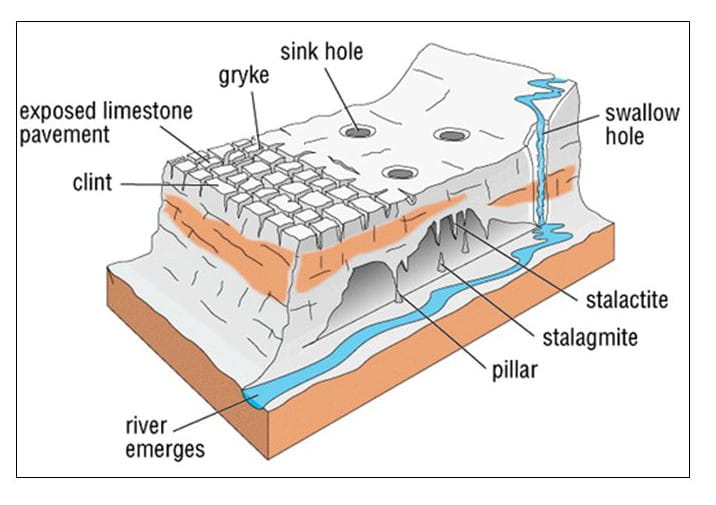Karst Topography
- Karst is a landscape which is underlain by limestone which has been eroded by dissolution, producing towers, fissures, sinkholes, etc.
- It is so named after a province of Yugoslavia on the Adriatic sea coast where such formations are most noticeable.
- Karst topography is a landscape formed from the dissolution of soluble rocks such as limestone, dolomite, and gypsum.
- It is characterized by underground drainage systems with sinkholes, caves etc..

Conditions Essential for Full Development of Karst Topography
- Presence of soluble rocks, preferably limestone at the surface or sub-surface level.
- These rocks should be dense, highly jointed and thinly bedded.
Erosional landforms of Karst Topography
The following are erosional Karst topography :
- Sinkhole
- Collapse sink
- Uvalas
- Caves
- Lapies
- Pools
Sinkhole
- Sinkhole topography is a very common erosional topography of the karst region.
- In the karst zone, swallow holes are first formed which are small to medium-sized round holes or shallow pits.
- Swallow holes are formed through the dissolution process.
- Over time, the swallow holes turn circular at the top and funnel-shaped at the bottom, called sinkholes, from where water seeps into the ground.
Collapse sink
- The topography formed after merging and collapsing of two or more sinkholes is called collapse sinkholes.
Uvalas
- When two or more sinkholes join after the collapse of their roof and form long, narrow wide trenches that are like a valley, which is called valley sinks or Uvalas.
caves
- Caves are formed in areas where limestone or dolomite rocks are present in between two other hard rocks (quartzite, sandstone). And later, caves are formed after the dissolution and erosion of limestone rocks.
- Usually, the caves are open on one side from which the stream of water comes out.
- Caves that are open from two sides are called tunnels.
Lapies
It is formed due to differential solution activity along parallel to sub-parallel joints. They are also called grooved, fluted and ridge-like features in an open limestone field.
Pools
An opening at the top with water collected in the void of the surface with varying depth

Depositional Landforms
Karst deposition landforms are often formed within the cave itself. As we know that the chemical composition of limestone is calcium carbonate which easily dissolves in carbonated water (carbonated water or dissolved carbon in rainwater). This is the deposition of calcium carbonate (and the water evaporates and the carbon dioxide is released) and creates a variety of landforms in the cave Three types of landforms are created:
- Stalactites
- Stalagmite
- Pillars
Stalactites
These stalactites are hanging pillars of various thicknesses that hang on the ceiling of caves. It is formed by the dripping of a mixed solution chosen from the ceiling.
Stalagmite
Stalagmite is formed by the deposition of calcium carbonate which rises up from the cave floor. It is also made from a mixed solution.
Pillar
When stalagmite accumulates from the floor of the cave to the ceiling. Such deposits are called pillar landforms.


